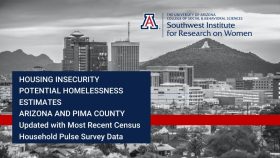
The University of Arizona Southwest Institute for Research on Women has released its thirty-eighth update to its report on Housing Insecurity Indicators and Potential Homelessness Estimates for Arizona and Pima County. This report measures current housing insecurity with newer census data. Without further analysis the causes of this locally are unclear, but the prime suspects are rising rents and the lingering aftermaths of the pandemic for the household budgets of lower-income households (via death, illness, and changes in employment and caretaking responsibilities).
Since the last census wave, there are points of significant concern. Those include:
- Disparities in financial strain along the lines of household incomes have increased in this and recent survey waves.
- Measures of households not being current on rental payments and those experiencing great difficulty meeting spending needs indicate that lower-income and BIPOC households in Arizona are slipping behind (again).
- Nationwide, individuals reporting that they have serious disabilities are increasingly disproportionately likely to report being behind on rent payments.
- It appears that members of historically marginalized groups (especially people living with disabilities) are not benefiting from the improved economy as quickly on average as other demographic groups.
- Simultaneously, inflation and increases in rents appear to be straining the finances of lower-income households despite a historically low unemployment rate.
- In September we observed the largest monthly count of eviction filings in Pima County since the onset of the pandemic.
The most recent update to the report also includes many indicators that have seen some improvement.
- Tucson rent prices appear to be slowing their rate of increase substantially in recent months.
- Tucson rent prices appear to be starting to decrease, albeit very modestly, in recent months. This is consistent with national trends and is likely a downstream consequence of recent interest rate hikes by the Federal Reserve.
- This reversal of recent trends is a very welcome relief, but does not erase the increases in average and median rents experienced over the past two years (which remain the area of 30-33% even after including the small recent declines in median rents).
- Statewide 69% of Arizona renters reported an increase in their monthly rent in the last year and 60% reported an increase of $100 or more. This indicates that most renters have been directly impacted by increases in rent prices in Arizona over the past year.
- Despite hardship caused by inflation, the positive macroeconomic situation has continued to hold steadily at the national and state levels
- Arizona unemployment has increased very modestly, but remains well below historical averages.
- In the previous survey wave, collected October 5th-17th 2022, the proportion of non-current renters was to 14.5%. In the most recent survey, conducted November 2nd-14th 2022, this proportion fell to 9.5%.
- In the October 2022 survey wave nearly a quarter of non-current renters (24%) reported viewing eviction in the next two months as “very likely”. The intensity of this indicator decreased further in November with only 16% of non-current renters viewing eviction as “very likely” in the next two months.
- The majority of Arizona renters who are behind on their rent, 79%, were only 1 or 2 months behind on their payments. That said, there was a substantial increase in the small proportion (7%) of non-current AZ renters who reported being 8 months or more behind on rent payments.
- In the previous report from mid-October, 81% of non-current renters had not applied for rental assistance, this proportion fell to 60% in the most recent wave.
- Mortgage holders in Arizona continue to be in a strong financial position. 5% reported being not current on mortgage payments (down from 6.2% in the previous survey) and of those that are not current <1% see a foreclosure in the next two months as “very likely” the lowest level of concern on this measure in this survey series to date.
